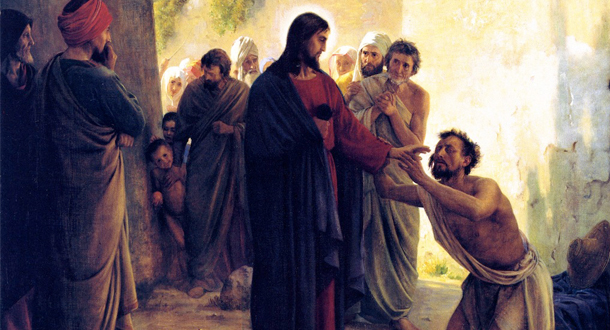
Scripture:
Reflection:
When Jesus and his disciples arrived at Bethsaida, people brought to him a blind man and begged Jesus to touch him. He took the blind man by the hand and led him outside the village. Putting spittle on his eyes he laid his hands on the man and asked, “Do you see anything?” Mark 8:22 – 23
When I reflect upon this passage from Mark’s Gospel, I’m reminded of the first lines of, Amazing Grace: “I once was lost, but now am found, Was blind, but now I see.”
At this point in Mark’s Gospel, Jesus is portrayed as a healer and teacher, but also as a very mysterious person, doing and saying things that no one understands.
We are introduced to Jesus by Mark at his baptism by John the Baptist, who was preaching a baptism of repentance and conversion. After John’s arrest, Jesus began his public ministry in Galilee by preaching that the Regin of God is at hand. And he makes a name for himself by a ministry of healing. He heals many illnesses, again and again, those possessed by demons, lepers and paralytics. And he heals many women as well.
However, Mark gives us only two accounts of Jesus healing blindness. This one, brought to Jesus by friends and the other, the one who cries out from the road. (10:46)
Several things strike me in this brief passage. The first is that “people brought to (Jesus) a blind man. . .” Who were these people? We are not told. Who was the blind man? We don’t know. The name of the second blind man Jesus heals of blindness is Bartimaeus. In that case, Bartimaeus initiates the contact and has to fight the crowd for him to be noticed by Jesus.
This healing was very different. Having been brought to Jesus, then Jesus takes him by the hand and leads him away from the village. Unlike the healing of Bartimaeus, this one takes place with no one watching. What can all of this mean? We need to take this to prayer.
Blindness is a human condition, not just a physical infirmity. Jesus addressed this social condition many times in his teaching and preaching. Jesus was especially harsh on the religious leaders whom he called “blind” over and over again because they were unwilling to recognize what was before their eyes: people suffering on account of their selfish human laws, justice ignored because they would have to admit to their compliance with injustice and to their own personal corruption and sin. This, too, we need to take to prayer!
While Jesus may have been healing a physical ailment, he was also pointing out to us the deeper significance of the blindness. With this particular encounter, Jesus is letting us know how difficult it is to regain a clear vision of our reality, much less comprehend the reality that sight and insight give us. Jesus will often refer to a passage in Isaiah that says, “they may look and see and not perceive.” Is. 6:9. He is also speaking to us.
It is only when we become acutely aware of our blindness do we go looking for the grace of sight and insight. It is then that we find meaning in a popular Church hymn: “Open my eyes, Lord, help me to see your face. Open my eyes, Lord, help me to see!”
Fr. Clemente Barrón, C.P. is a member of Mater Dolorosa Community in Sierra Madre, California.
